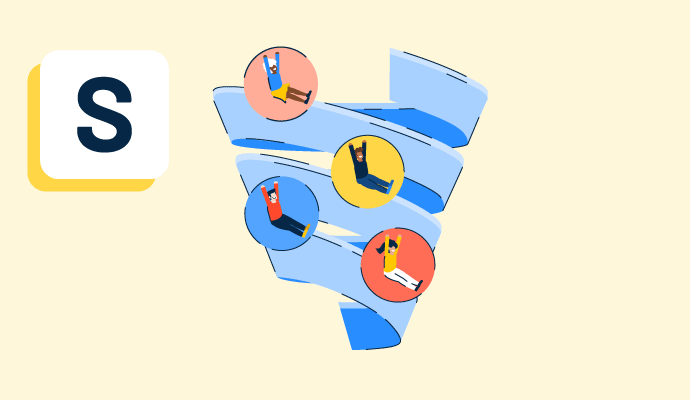What is a sales funnel?
A sales funnel is a marketing term used to describe a customer's journey from first contact to purchase.
The infrastructure of a sales funnel differs from company to company. Customers may linger in a particular stage before moving into the next step or leaving the funnel entirely. Any gaps in the funnel can mean lost sales.
Businesses typically track where customers are in the sales funnel with their customer relationship management (CRM) systems. This central hub for prospect information means businesses can shepherd these individuals down the funnel until they make a purchase by personalizing their communications and improving the experience for the prospective customer.
Types of sales funnels
Most businesses have a single standard sales funnel, but different objectives within a company can necessitate having several sales funnels that contribute to the larger funnel.
- Lead generation sales funnels. The goal here is simply to get more leads. This could be through email sign-ups, improving search engine optimization (SEO), or running paid ads on social media to build awareness at the top of the overarching sales funnel.
- Content sales funnels. Any information created to market a business is content. These sales funnels create a content marketing strategy by posting videos or interesting social media posts. Within the content, calls to action move the leads through the funnel.
- Call booking sales funnels. Getting a prospect on the phone with the sales team can be the make-or-break for some businesses. These funnels typically offer call booking incentives to get customers from the interest stage to purchase more quickly.
- Limited time offers sales funnels. Similar to a call booking funnel, a limited-time offer or discount can interest a potential customer and encourage a faster sale. Retargeting ads often work well here, particularly in e-commerce, where prospective customers may have abandoned their online shopping cart before purchasing.
Elements of sales funnels
No matter what a company’s sales process looks like, the funnel always starts with the widest net of possible customers. Over time, the opening becomes narrower as prospects move toward a purchase.
- Awareness or prospect. This is when a prospective customer becomes aware of the brand. It’s the stage of the funnel with the largest group of people. Through dedicated marketing efforts, a percentage of this group moves to the next step.
- Interest or qualified lead. Once a prospect has become aware of the brand, they decide whether or not they're interested in a company’s product or service.
- Decision or intent to purchase. If a prospect wants to pursue a particular business based on their first research stage, they look for detailed information at this stage. Pricing and availability become crucial here because this is when the prospect decides whether to buy or not.
- Action or sale made. Even if a prospect has decided to buy, the deal isn't sealed until the money is handed over to the business. Nurturing prospects to this end stage of the funnel is the most crucial move a business can make to succeed.
Benefits of sales funnels
A sales funnel is the best way for sales and marketing teams to understand their customers' lived experiences better. They also:
- Create customers for the business. The whole point of the funnel is to create more sales. A dedicated funnel increases a company’s chances of narrowing its target audience to only those most likely to make a purchase.
- Give insight to the sales and marketing teams. Understanding prospects means that marketing and sales teams can gain better insight into their target audience. This means that the budget can be focused on qualified leads rather than wasted on those who will likely never make a purchase.
- Monitor and track key metrics. Working from accurate data ensures that sales and marketing teams make the most of their resources. A dedicated CRM to track sales funnel information makes adjustments possible more quickly.
Best practices for sales funnels
Building an effective sales funnel comes down to knowing exactly who the target audience is and what it takes to get them from awareness to action.
- Analyze existing customers. A deep understanding of existing customers entices new prospects. Gather data on common customer issues.
- Build a landing page with something valuable for the prospect. This is the chance to make an excellent first impression. Clear calls-to-action lead prospects to the next funnel stage.
- Start nurturing leads as quickly as possible. Sales and marketing teams must convince leads to convert as close to immediately as they can
- Upsell at the final stages of the funnel. An extended trial, a discount, or a free addition to the product they're looking at are all good options.
- Review sales data to pinpoint cracks in the funnel. Prospects always drop off during the sales funnel. Understanding where and why this is happening keeps some of those customers in the funnel for longer and results in more sales in the future.
Target the right customers at the ideal time when you track their progress through the sales funnel with CRM software.

Holly Landis
Holly Landis is a freelance writer for G2. She also specializes in being a digital marketing consultant, focusing in on-page SEO, copy, and content writing. She works with SMEs and creative businesses that want to be more intentional with their digital strategies and grow organically on channels they own. As a Brit now living in the USA, you'll usually find her drinking copious amounts of tea in her cherished Anne Boleyn mug while watching endless reruns of Parks and Rec.

